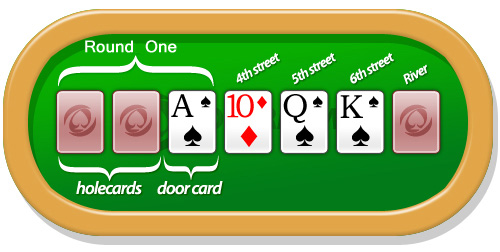Fundamentals of Poker - Seven Card Stud
- Official Seven Card Stud Poker Rules. Omaha is similar to hold'em in using a three-card flop on the board, a fourth board card, and then a fifth board card.
- One of the top 7 Card Stud Poker strategies is to determine which starting hand can be played and which ought to be folded to cut further losses. Players can do this by first finding out if the cards needed to create the desired hand are live or not. A card is termed as “live” when it is still in play.
How to play 7 Card Stud Poker. 7 Card Stud Poker card game is one of the most popular variants of video Poker available for free.It is a fast single player video Poker game that principally works on the rule of seven cards per hand with an option of altering your the wagering limit on every deal.
- General Guidelines
- Seven Card Stud
- Limit Texas Hold'em
As we have stated, seven-card stud is an intricate game, and determining the best possible play in a given situation involves numerous factors. So before we get into specifics on what hands to play and how you should play them, following are a few tips that will help you make the correct decisions.
Play live hands
Seven-card stud, as its name implies, is a seven-card game. Consequently, you should play hands that have a good chance to improve. For example, if you start with three cards of the same suit — called a three flush — and several other cards of this suit are out on board, your hand is said to be dead and therefore should be thrown away. By the same token, if only one or two of your suited cards are showing, you have a hand of value that should be played in most situations.

Big pairs play better against only one or two opponents, while drawing hands prefer lots of company.
A hand like the
and a hand like the
are both good hands, but they play much differently. Big pairs usually do best when played in short-handed pots, because against only a few opponents, a big pair has a reasonable chance of winning without improvement.
The opposite is true of the drawing hands, such as a three flush or a three straight. Although these are good starting hands, they have no immediate value. Moreover, you will not complete your flush or straight very often. You therefore prefer to have many opponents, so that when you do make your hand, someone will still be around to pay it off.


Small and medium pairs are much worse than big pairs.
A hand like the
and even a hand like the
are occasionally good hands. But in general, there is a big difference in strength between these hands and the big pairs. For example, when you play a small or medium pair, one of your opponents could easily have you beaten or can catch a card higher than your pair, which would give him a bigger pair that will beat you.
Having one or more high cards adds value to your hand.
We have just touched on this. Holding a high card allows you to catch another card of the same rank, which might be enough to win the pot. Having more than one high card is even better.
Be aware — and beware — of scare cards.
A scare card is a card that either improves your hand or allows you to catch another card that will improve your hand. For example, catching a suited jack on fourth street to go along with a king adds enormous value to your hand. Your opponent now has to worry about a possible straight or flush, as well as a possible big pair. Likewise, you need to be concerned when your opponent catches a scare card.
How To Play Seven Card Stud
It is often correct to chase.
Even though you should be selective of the hands you play, once you enter a pot, it’s often correct to go all the way. This is sometimes true even when you are sure you don’t have the best hand. Of course, if your hand becomes hopeless, you should discard it. But in many situations, you will have enough ways to win that chasing is worthwhile.
Poker Strategy and Other Topics - November 2019
by Carlos Welch
by Robert Samuels
by Kevin Haney
by Kevin Haney
by Ben Saxton
by Bryan Clark
by Felipe Garcia, CFA and Aaron Byrd, CFA
by Nick Willett
by Mason Malmuth
As you probably know, Holdem is the most popular game today. But what many new players don't realize is that until recently the most popular game was 7 Card Stud poker.
Most of the same skills that apply to win hold'em play apply to 7 Card Stud poker as well. One skill that is much more important in 7 Card Stud poker than in other forms of poker is short-term memory.
You must be able to remember what cards your opponents who folded had shown in order to determine your correct odds as well as the possibilities of what your remaining opponents may be holding.
7 Card Stud poker is played mostly for high only, but is also occasionally available in high/low split. Both are played using the following rules.
Up to eight players may play in a 7-card stud poker game. Each player places an ante and then receives two down cards and one face-up card. The lowest face-up card is required to start the betting action with a bet called the bring-in.
The player with the lowest card showing may bet either half the lower betting limit or place a full bet (called completing the bet) or raise, with play continuing to the left. If the bring-in is only half a bet, another player may complete the bet or raise (complete the bet and raise).
After all betting is completed; a fourth card is dealt face up to each player. From this point on, the highest hand showing starts the action each round. Each player, in turn, may check or bet if there has been no action or call or raise when facing a previous bet.
On this round, if the high hand is a pair, this player may check, bet the lower limit or the higher limit. There is no bring-in requirement after the first betting round. A fifth card is dealt face up followed by a betting round and a sixth card is dealt face up followed by another round of betting.
The seventh card is dealt to each player face down and the final round of betting starts. Each round is often called a street (the third card is called third street, the fourth card is called fourth street and so on through seventh street).
The betting on the third and fourth street is the lower limit and on fifth, sixth and seventh street it is the higher limit. Each player uses his or her best five cards to form a hand.
If playing high/low split, each player uses five cards to form their best high hand and five cards to form their best low hand. These do not have to be the same five cards.
In 7 Card Stud poker high/low split, there is often an 8 qualifier. This means that to have a hand that qualifies for low, you must have five non-paired cards eight or below.
One thing that often confuses players is how to correctly determine which hand is the lowest. The easiest way to do this is to read the hands backwards like a number.
For example, 8 5 3 2 A would be read 85,321. The lower the number, the lower the hand. Here are a few examples in order from lowest to highest to help you understand how this works.
A 2 3 4 5 54,321
A 2 4 5 6 65,421
2 3 4 5 6 65,432
3 4 5 6 7 76,543
A 2 3 4 8 84,321